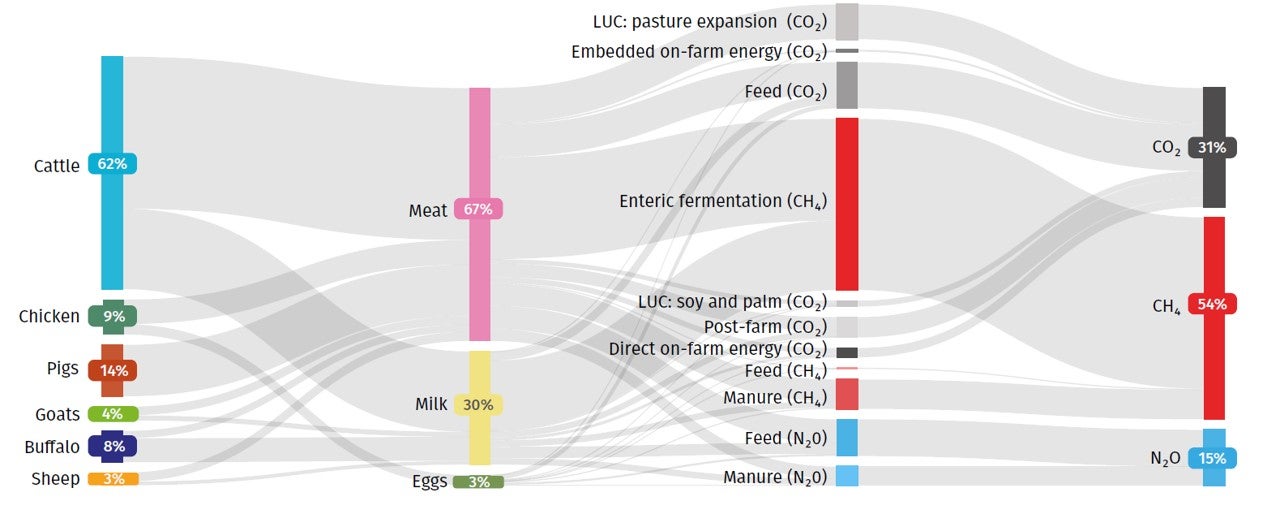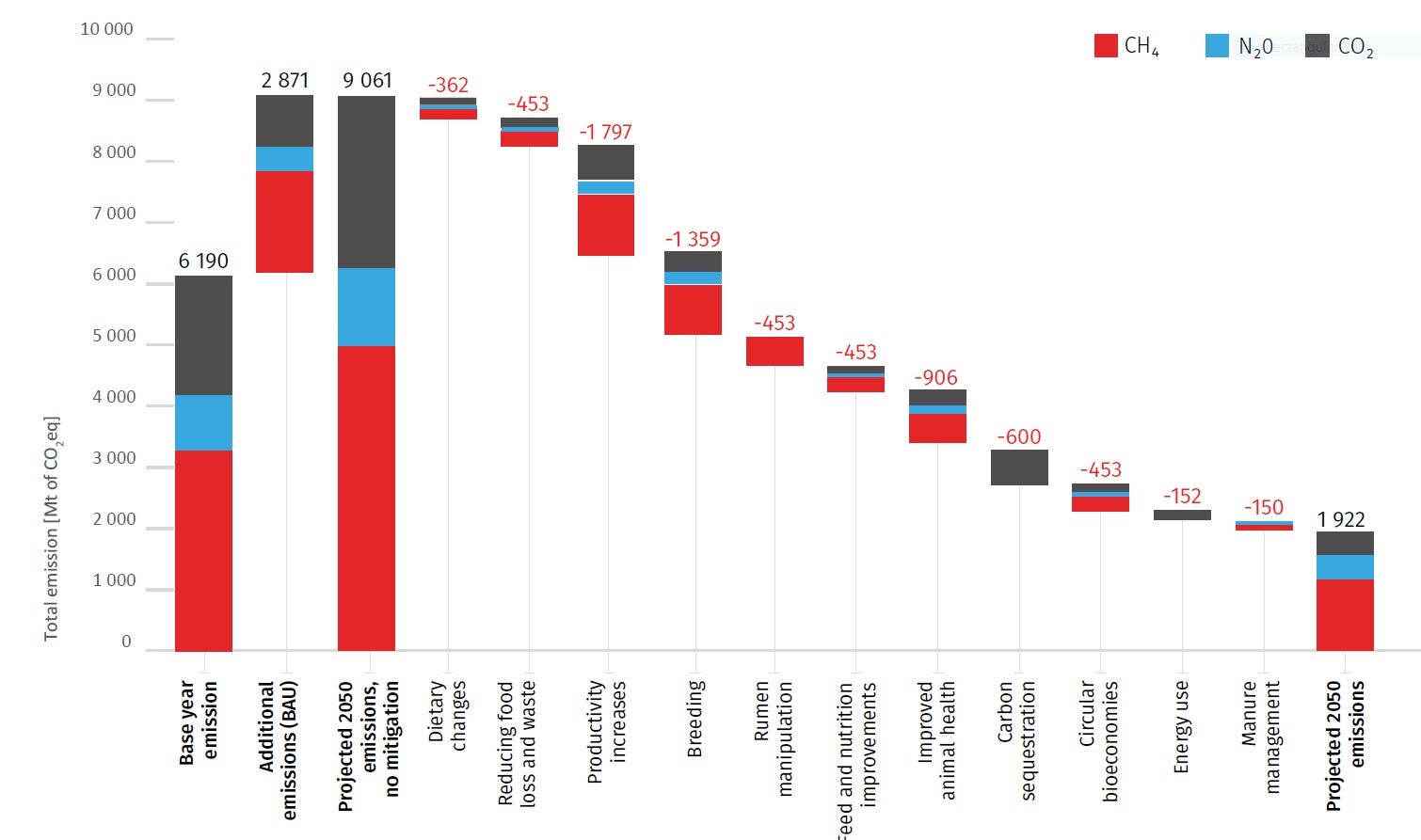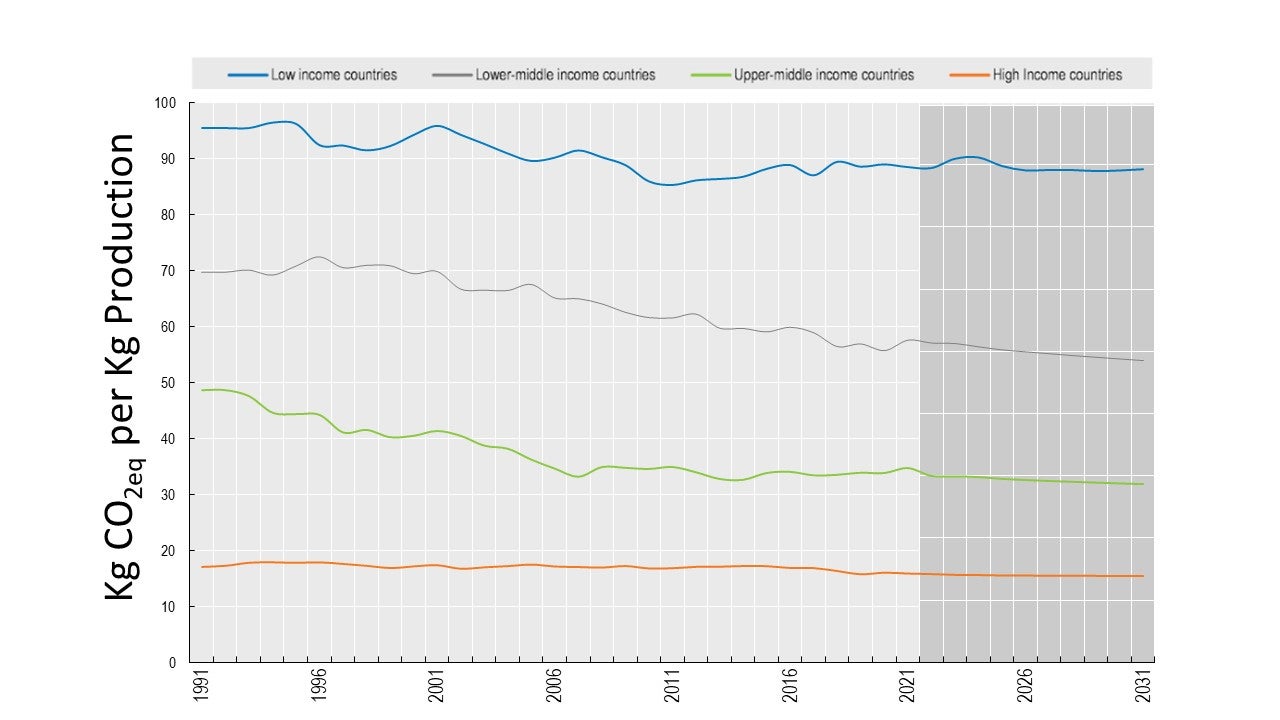A 2023 report from the FAO “Pathways towards lower emissions: A global assessment of the greenhouse gas emissions and mitigation options from livestock agrifood systems” revised their previous lifecycle assessment (LCA) estimate of the percentage of greenhouse gas (GHG) due to livestock to be 6.2 gigatonnes (Gt) of carbon dioxide equivalent (CO2eq), equating to approximately 12% of of the estimated 50 to 52 Gt CO2eq total anthropogenic GHG emissions in 2015.
Direct emissions from the livestock sector globally, encompassing CH4 from enteric fermentation, and CH4 and N2O from manure management, amount to 3.7 Gt CO2eq which is equivalent to approximately 60 percent of livestock emissions, or 7.2% of total emissions. Terrestrial animal source foods (TASF) were associated with emissions contributed by cattle (62%), followed by pigs (14%), chickens (9%), buffaloes (8%), and small ruminants (sheep and goats, 7%) (Figure 1).

Figure 1. Sankey diagram of emission sources in 2015 by species, products, sources of emissions and gasses. CH4 = methane (red), N2O = nitrous oxide (blue), CO2 = carbon dioxide (grey).
The report further estimated that population and demand growth, primarily in Africa, will drive a further 20% increase in animal product demand by 2050 compared to 2020 levels. In the absence of any intervention or improvements in productivity it is estimated that this increase will drive global livestock emissions to nearly 9.1 Gt CO2eq by 2050.
A comprehensive literature review included in the study suggested that improvements in animal production, adoption of known feed and nutrition practices, and improving animal health and welfare were the most promising interventions to reduce GHG from this sector. Other practices such as breeding, changes in consumption of TASF, reducing food loss and waste, and rumen manipulation were considered to lower but still important mitigation potentials (Figure 2).

Figure 2. Base year and projected emissions from livestock systems shown as a waterfall chart with a range of mitigation measures applied to 2050 with their technical potential Note: 100 percent adoption is assumed. Interventions are assumed to have cumulative impacts and the order of interventions is thematically structured, without the intention to rank them for their importance.
“The most significant reductions in both absolute and relative emissions can be achieved by prioritizing improvements in productivity, not only per animal but also by optimizing efficiency at each stage of the production chain.” FAO (2023) Pathways towards lower emissions
This report succinctly summarizes the impact of what many animal scientists like myself have been working on for years, innovations in the three main disciplines of animal science; genetics, nutrition and health, historically supported by extension programs that facilitate adoption of best practices, have been associated with large decreases in the emissions intensity (emissions produced per unit of product) in developed countries. However, this improvement has not been universal, and many low and middle income countries (LMIC) have production systems with high emissions intensities.Global average values of emission intensities hide a lot of heterogeneity, and mask the decreases enabled by the adoption of innovations.
Figure 3 shows that high income countries have dramatically decreased the emissions intensity of cattle meat relative to those seen in low income countries. LMIC are home to 76% of the global cattle herd and contribute 75% of the global ruminant greenhouse gas emission emissions. Chang (2021) estimated that improving livestock production efficiencies in the 10 countries with the largest emission reduction potential (Madagascar, Morocco, Niger, South Africa, Tanzania), Asia (China, India, Iran, Turkey) and South America (Brazil) could contribute 60%–65% of the global reduction in livestock emissions by 2050 (compared to a baseline where emissions intensities are held constant in the future). These authors stated that improving production efficiency has a much greater mitigating effect than demand-side efforts, and should be prioritized in a few countries

Figure 3. Beef GHG emissions intensity per regions. Note: Estimates are based on historical time series from the FAOSTAT Emissions Agriculture databases which are extended with the Agricultural Outlook projections. CO2 equivalents are calculated using the global warming potential of each gas as reported in the IPCC Sixth Assessment Report (AR6). Image from https://doi.org/10.1787/f1b0b29c-en
Academic animal scientists making nuanced, well-supported points about the importance of global livestock production systems, the need for innovation, explaining that emission sources and the specific gases involved vary considerably across locations, livestock species and production systems and emphasizing that global averages conceal important local differences, are often dismissed outright by critics as having a vested interest, or being industry apologists, or even worse they are accused of being paid sock-puppets as I wrote about in BLOG last year. Something similar happened to me when I dared to speak out on the science and considerable evidence base on the safety of the highly politicized topic of genetically modified food, and dared to publish a peer-reviewed paper suggesting that there is no scientific evidence that the literally billions of livestock eating GMO feed every year had suffered any ill-effects.
The multitude of complex trade-offs that should legitimately be part of conversations around differing food production systems and dietary shifts are often dichotomously framed, frequently envisaging a future where people have to pick a kingdom – plant or animal – for dinner. These needlessly simplistic binaries are unproductive, often alienating or disaffecting the very people whose goodwill, cooperation and knowledge will collectively be required to reduce the environmental footprint of food production while addressing projected demand. This binary led over 1,000 scientists working in a multitude of disciplines from universites and research institutions around the globe to sign The Dublin Declaration on the Societal Role of Livestock which states:
Livestock systems must progress on the basis of the highest scientific standards. They are too precious to society to become the victim of simplification, reductionism or zealotry. These systems must continue to be embedded in and have broad approval of society. For that, scientists are asked to provide reliable evidence of their nutrition and health benefits, environmental sustainability, socio-cultural and economic values, as well as for solutions for the many improvements that are needed. This declaration aims to give voice to the many scientists around the world who research diligently, honestly and successfully in the various disciplines in order to achieve a balanced view of the future of animal agriculture.
The integrity of the scientists who wrote this declaration has been questioned in the media, and in fact even the FAO itself, has recently come under attack for daring to revise its livestock emmisions estimates in GLEAM 3 based on incorporating refinements made to the 2006 guidelines of IPCC in 2019. Science does that over time, revises based on new data. A response from one of the authors of the Declaration Prof. Frédéric Leroy (CoI; Vrije Universiteit Brussel, Belgium to these criticisms is detailed in his BLOG entitled, “Activist tactics and the discrediting of scientists.” He writes, “This opinion piece was written in protest to persistent attempts to undermine the credibility of established experts and organizations in the domain of animal source foods and livestock agriculture. This is now typically done by unfairly labelling prominent research and science communication that do not align with certain (largely ideological) perspectives as untrustworthy and perversely influenced by industry. Yet, the validity of the actual scientific arguments and evidence, that have been diligently provided by numerous established experts in the interdisciplinary domain of animal production (and far beyond), are rarely addressed in an appropriate manner. The recent smear campaign against the Dublin Declaration is an illustration of this ongoing trend to silence ‘inconvenient’ science”.
Scientists who are subject matter experts willing to speak up on politicized topics have frequently become the target of online attacks and harassment campaigns, seemingly intended to silence their viewpoint. False accusations of industry connection with “BIG” [insert relevant industry here] are made to delegitimize their voice, and unfortunately, this has often proven effective at discouraging those who are unwilling to subject themselves and their reputation to such harms. This is particularly problematic when the topic is agricultural innovations because demonizing agricultural scientists and basing agricultural decisions on ideology rather than evidence has a long history of mass famines and economic collapse including the Great Leap Forward, the “Holodomor”, and most recently the 2022 collapse of the Sri Lankan economy.
I have no doubt this FAO report will come under fire for putting the reduction potential from changes in consumption of TASF at only 4%, calculated by “prorating the emissions reductions of 0.19–0.53 Gt CO2eq per year” estimated by Behrens (2017). This paper “Evaluating the environmental impacts of dietary recommendations the global food systems”, was published in PNAS. The authors reported that compared with average diets, nationally recommended diets (NRDs) in high-income, upper-middle–income nations are associated with reductions in GHG from 13.0 to 24.8%, and 0.8–12.2%, respectively, and increases in GHG by 12.4–17.0% in and poorer middle-income countries. The majority (54%) of the reduced environmental impact in high-income countries was driven by reductions in calories (i.e. eating the recommended number of calories rather than in excess of what is needed), and 46% by shifting the increased fruit, vegetables and nuts at the expense of sugars, oils, meat, and dairy! The increased GHGs of NRDs in LMIC were associated with recommendations for increased intake in animal products, partly due to the relatively high prevalence of undernutrition and micronutrient deficiencies in these regions. The authors of this study concluded that “Overall, our results show that in many cases, there are environmental impact benefits to adopting NRDs. At present these benefits are smaller than other interventions in the environmental impact of food systems such as reductions in food waste.”
The fact is that improvements in animal production were seen as the most promising interventions to reduce GHG from this sector in the FAO report, based on an analysis of FAOSTAT production data at regional level, coupled with assumed 100% adoption of known feed and nutrition practices, breeding, rumen manipulation and improving animal health and welfare suggests animal scientists and extensionists are going to be key players in helping to reduce TASF emissions by 2050. I might posit that this might be an easier task than convincing 100% of high income consumers that they need to reduce consumption to the NRD-recommended number of calories, even though perhaps everyone can agree that this would be good for both human health and the envronment. The FAO report concludes,
“to realize the modelled pathways and effectively reduce emissions by 2050, the adoption of proposed practices at the local level is essential. Given the complexity and diversity of farming systems, mitigation interventions should be customized to suit specific local contexts. Collaborative efforts from all industry stakeholders are critical to successfully mitigate the anticipated increase in sectoral GHG emissions. Based on the presently available data, this path appears both viable and effective.” FAO (2023) Pathways towards lower emissions
The wide adoption of relatively simple, proven animal science innovations has had, and will continue to have, considerable potential to improve the efficiency of milk and meat production in both high income and developing countries. The challenge in LMIC is that these technologies are often too expensive or difficult to implement in the absence of the required infrastructure and technical expertise. The adoption of agricultural technology in now developed countries has historically been done in collaboration with publicly-funded extension efforts to work with developers to field test and refine products, optimize efficient and practical protocols, perform field demonstrations with farmer collaborators to ground truth and ultimately promote the adoption of cost-effective, evidence-based agricultural innovations.
Such a strategy, including public-private partnerships and investment, will likely be required to facilitate widespread (or even the 100% ambitiously assumed in the FAO report) adoption of proven technologies. This will undoubtedly require collaborations among established experts in the interdisciplinary domain of animal production and most importantly the producers that will implement these practies. As someone who has worked in two controversial fields: animal science (and furthermore cattle!) and biotechnology, as an extensionist and researcher for my entire career, I worry that students, early career academics and allies interested in pursuing efforts to help to produce TASF with higher quality, efficiency and environmental and economic sustainability will be dissuaded from working in this important field based on misinformation regarding the integrity of animal science, right at the time when the adoption of innovation is most needed to ensure future demand is addressed by more efficient animal production systems, rather than an ever increasing number of animals.